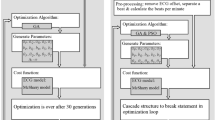Abstract
Seismocardiogram (SCG) recording is a novel method for the prolonged monitoring of the cardiac mechanical performance during spontaneous behavior. Thousands of beats are recorded during a variety of physical activities so that the automatic analysis and processing of such data is a challenging task due to the presence of artefactual beats and morphological changes over time that currently request the human expertise. We propose the use of the evolving fuzzy neural network (EFuNN) paradigm for the automatic artifact prediction in the SCG signal. The fuzzy logic processing method can be applied to model the human expertise knowledge using the learning capabilities of an artificial neural network. The evolving capability of the EFuNN paradigm has been applied to solve the issue of the physiological variability of the SGC waveform. Tests have been carried out to validate this approach. The obtained results demonstrate that the EFuNN’s evolving capabilities are effective to solve most of the issues related to the learning and to the scalability of the method on an off-the shelf computing platform.



Redrawn from (Di Rienzo et al. 2012) by permission












Similar content being viewed by others
References
Crow RS, Hannan P, Jacobs D, Hadquist L, Salerno DM (1994) Relationship between seismocardiogram and echocardiogram for events in cardiac cycle. Am J Noninvasive Cardiol 8:39–46
Di Rienzo M, Meriggi P, Vaini E, Castiglioni P, Rizzo F (2012) 24 h seismocardiogram monitoring in ambulant subjects. In: Proceedings Conference IEEE EMBS, San Diego, 2012, pp 5050–5053
Di Rienzo M, Vaini E, Castiglioni P, Lombardi P, Meriggi P, Rizzo F (2014) A textile-based wearable system for the prolonged assessment of cardiac mechanics in daily life. In: Proceeding Conference IEEE EMBS, 2014, 6896–6899
Ferrandez M, Sanchez J.R.A, de la Paz F, Toledo FJ (eds) (2011) New challenges on bioinspired applications. In: 4th international work-conference on the I interplay between natural and artificial computation, IWINAC 2011, May–June 2011, Proceeedings, Part 2, LNCS6687 Springer, 2011
Ghosh Dastidar S, Adeli H (2009) A new supervised learning algorithm for multiple spiking neural networks with application in epilepsy and seizure detection. Neural Netw 22(10):1419–1431
Inan O, Migeotte PF, Park KS, Etemadi M, Tavakolian K, Casanella R, Zanetti J, Tank J, Funtova I, Prisk GK, Di Rienzo M (2015) Ballistocardiography and seismocardiography: a review of recent advances. J Biomed Health Inform 19(4):1414–1427
Indiviery G, Horiuchi T (2011) Frontiers in neuromorphic engineering. Front Neurosci 5:118
Kasabov N (1998) Evolving fuzzy neural networks – algorithms, applications and biological motivation. In: Yamakawa T, Matsumoto G (eds) Methodologies for the conception, design and application of the soft computing, World Computing, pp. 271–274
Kasabov N (2001a) EFuNN. IEEE Tr SMC
Kasabov N (2001b) Ensembles of EFuNNs: An architecture for a multimodule classifier. In: Proceedings of the international conference on fuzzy systems. vol 3, Australia, 1573–1576
Kasabov N (2007) Evolving connectionist systems: the knoledge engineering approach. Springer, Heidelberg
Kasabov N (2014) NeuCube: a spiking neural network architecture for maping, learning and understanding of spatio-temporal brain data. Neural Netw 52:62–76
Kasabov N, Song Q (2001) ECM, a novel on-line, evolving clustering method and its applications. In: Proceedings of the fifth biannual conference on artificial neural networks and expert systems (ANNES2001), pp 87–92
Kasabov N, Dhoble K, Nuntalid N, Indiveri G (2013) Dynamic evolving spiking neural networks for on-linespatio-and spectro-temporal pattern recognition Neural Netw 41:188–201
Minku FL, Ludermir TB (2006) EFuNNs ensembles construction using a clustering method and a coevolutionary genetic algorithm, CEC’2006, Vancouver, Canada
Minku FL, Ludermir TB (2008) Clustering and co-evolution to construct neural network ensembles: an experimental study. Neural Netw 21(9):1363–1379
Scliebs S, Kasabov N (2013) Evolving spiking neural networks—a survey. Evolving Syst 4(2):87–98
Sutton S, Barto B (1998) Reinforzed learning: an introduction. Adaptive computation and machine learning, MIT press, Cambridge
Acknowledgements
A special acknowledgment is due to Prof. Nikola Kasabov, Auckland University of Technology, Director KEDRI—Knowledge Engineering and Discovery Research Institute for his invaluable suggestions related to how to take the best from the EFuNN’s evolving capabilities.
Author information
Authors and Affiliations
Corresponding author
Additional information
Publisher’s Note
Springer Nature remains neutral with regard to jurisdictional claims in published maps and institutional affiliations.
Rights and permissions
About this article
Cite this article
Malcangi, M., Quan, H., Vaini, E. et al. Evolving fuzzy-neural paradigm applied to the recognition and removal of artefactual beats in continuous seismocardiogram recordings. Evolving Systems 11, 443–452 (2020). https://doi.org/10.1007/s12530-018-9238-8
Received:
Accepted:
Published:
Issue Date:
DOI: https://doi.org/10.1007/s12530-018-9238-8




